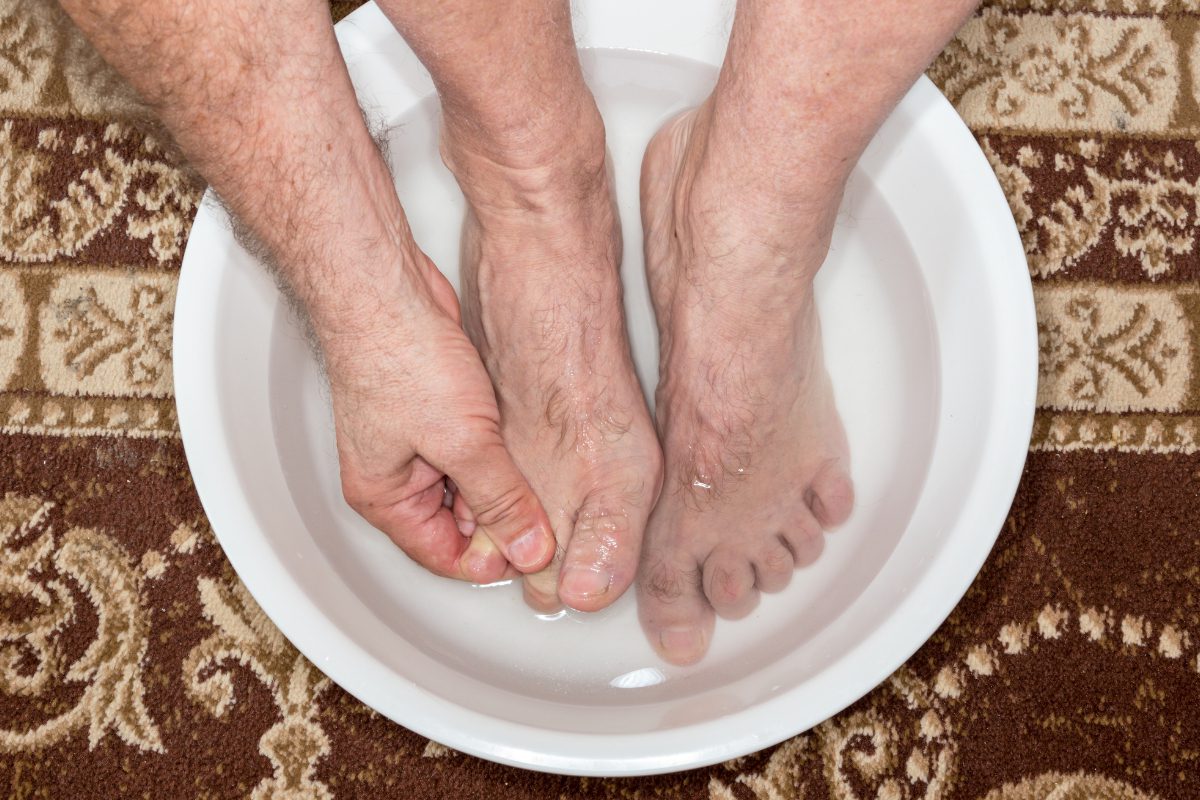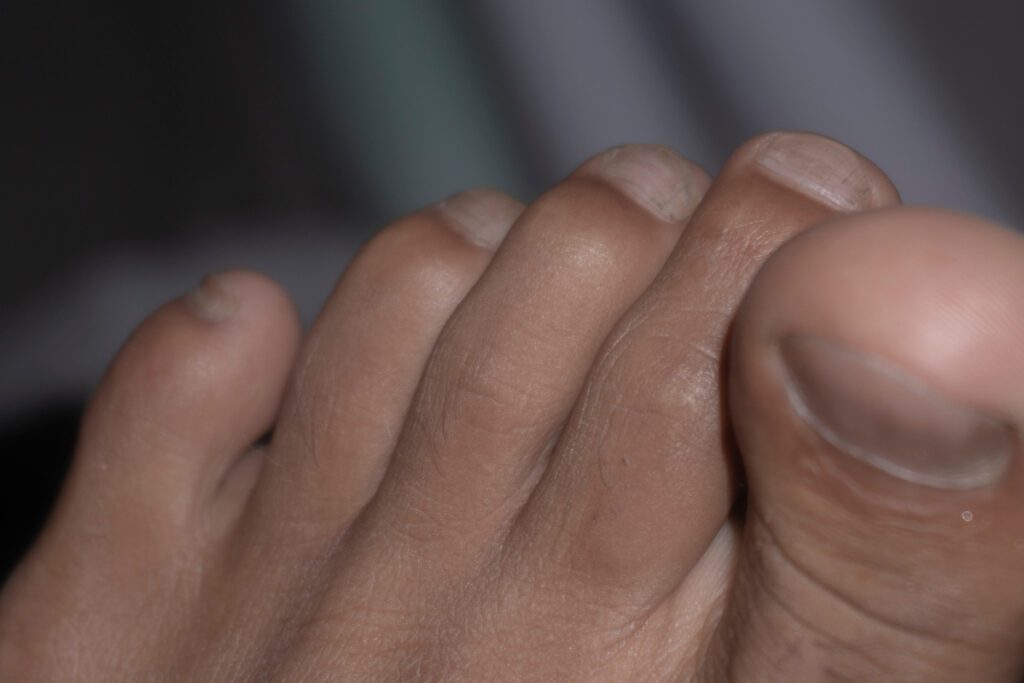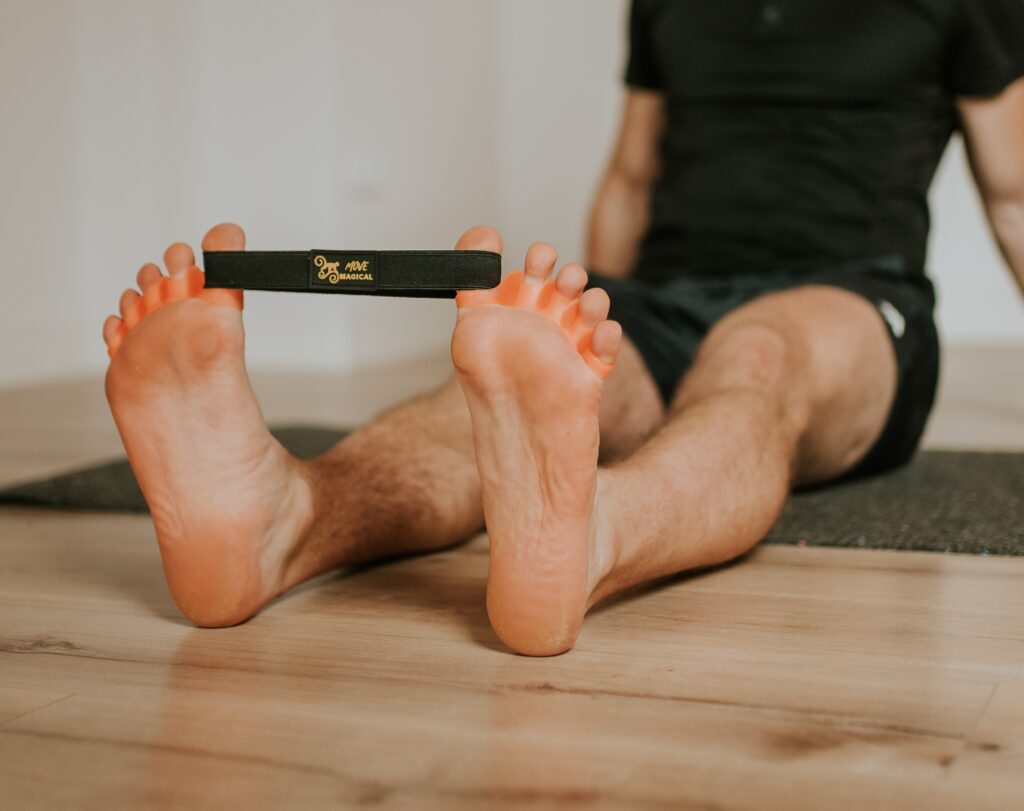
It’s time to discuss another type of foot deformity and some hints on how to combat it – in this article you’ll learn what hammer toes are. If you are interested in other types of deformities, check out our articles on:
- Bunion foot,
- Flat feet,
- Bunion toe.
Hammer toe is a foot deformity that can cause pain, discomfort and problems with walking. Therefore, it is worth learning about its characteristics, symptoms, causes and treatment methods to be able to effectively counteract this condition. In the rest of this article, we will discuss these issues in detail to provide readers with a comprehensive knowledge of hammer toes.
What are the characteristics of hammer toes?
Hammer toe is a deformity in which the hammer-like finger is bent at the interphalangeal joint, leading to a contracture of the finger. In the case of hammer toe, there is a similar deformity, but it also involves the metatarsophalangeal joint. In both cases, the toes are bent and contracted, which can cause pain and discomfort when walking.
It is worth noting the differences between hammer toe and hammer toe conditions. With hammer toe, flexion of the toe occurs only at the interphalangeal joint, while with hammer toe, flexion also involves the metatarsophalangeal joint. In both cases, the deformity can affect the length of the finger in question and the function of the metatarsophalangeal joint.
Hammer toe deformity can be uncorrective or corrective. Non-corrective deformity means that the finger is so bent and contracted that it cannot be straightened by hand. In the case of a corrective deformity, the finger can be straightened manually, which can facilitate treatment and rehabilitation.
It is also worth mentioning that a hammer toe deformity can affect one or more fingers. Depending on the severity of the deformity, it can affect the overall performance of the foot and walking comfort. In the case of an advanced deformity, the toe may be so bent that its tip touches the ground. This will lead to pain and abrasion of the skin on the tip of the toe.
 Symptoms of hammer toes
Symptoms of hammer toes
Symptoms of hammer toe can vary, but the most characteristic are complaints of toe pain, calluses and corns. As hammer toe begins to develop, other symptoms can also occur, such as changes in the appearance of the fingers, difficulty walking or wearing shoes.
Toe pain is one of the most troublesome symptoms of hammer toe. Finger pain can be caused by both joint deformity and pressure on the tip of the finger when walking. As the deformity progresses, the pain can worsen, which can make daily functioning difficult.
Calluses and corns are other common symptoms that hammer toe causes. Calluses are thickened skin that form due to constant pressure on a particular part of the foot. Corns, on the other hand, are calloused, painful skin lesions that can occur on the toes or soles of the feet. In the case of hammer toes, calluses and corns can appear on the tips of the toes, on the outside of the fingers or on the soles of the feet, where the toe touches the ground.
It is worth noting that the symptoms of hammer toes can vary depending on the severity of the deformity and the individual characteristics of the patient. In some cases, the symptoms may be mild and not significantly affect the comfort of life, while in others they may be so severe that they make walking or wearing shoes difficult. Therefore, it is important to monitor the development of symptoms and, if necessary, consult the doctor.
How do hammer toes develop?
The causes of hammer toes are varied and may be related to genetic factors, wearing inappropriate footwear, or other factors. Among the most common causes of hammer toes are:
- Congenital causes of occurrence – some people are born with a predisposition to develop hammer toes. This may be due to genetics or other environmental factors;
- Excessive toe length – when one toe is significantly longer than the others, deformities can occur, leading to hammer toe;
- Wearing shoes that are too tight – shoes that are too tight can put pressure on the toes, leading to toe deformity over time;
- Secondary causes – hammer toe can also be the result of other conditions, such as rheumatoid arthritis, diabetes or neurological diseases.
All of these factors can lead to the joint deformities and finger pain that are characteristic of hammer toes. It is worth noting that not always one cause is sufficient to cause deformity – often it is the result of the interaction of several factors.
Footwear-related causes, i.e. wearing shoes that are too tight, can lead to pressure on the toes, which over time leads to deformity. It is worth paying attention to ensure that footwear fits the foot properly without causing pressure on the toes.
In the case of genetic causes, people with a family history of hammer toes are more likely to develop this deformity. It is then worth monitoring the condition of the feet and consulting a specialist if necessary.
In the case of secondary causes, treatment of the underlying disease can help reduce the risk of hammer toes. It is worth paying attention to monitor the condition and consult a doctor regularly.
Treatment options for hammer toe
Treatment can be carried out in various ways, depending on the severity of the deformity and the individual needs of the patient. There are mainly conservative treatment methods and surgical treatment. The right approach to therapy can significantly alleviate symptoms and improve the function of the foot.
Conservative methods of treatment
Conservative treatment of hammer toe includes various methods that aim to reduce pain, improve the function of the foot and prevent further deformities. Among the conservative methods are:
- Exercise – regularly performing exercises to strengthen foot muscles and stretch tendons can help treat hammer toes;
- Shoe changes – wearing properly fitted, wide shoes with soft material can reduce pressure on the toes and prevent further deformities;
- Cushions and toe separators – the use of special cushions and toe separators can help maintain proper toe alignment and reduce pain;
- Hammer toe orthoses – the use of orthoses can help maintain proper toe alignment and prevent further deformities.
 Hammer toe surgery – methods of operation, course of operation
Hammer toe surgery – methods of operation, course of operation
In cases where conservative treatment of hammer toe is not successful, surgical treatment of hammer toe may be necessary. There are several methods of surgery to correct the deformity and restore normal function to the foot. The choice of method depends on the severity of the deformity and the individual needs of the patient.
Hammer toe surgery may include cutting tendons, removing part of the bone, or stabilizing joints with implants. The course of surgical treatment depends on the method chosen and the patient’s condition. After surgery, appropriate rehabilitation of the hammer toe is necessary.
Hammer toes – rehabilitation
Rehabilitation after surgery is a key part of returning the foot to full function. This process includes:
- Exercises – performing exercises to strengthen foot muscles and stretch tendons to restore proper foot function;
- Physiotherapy – the use of various physiotherapy techniques, such as massage, electrostimulation and ultrasound therapy, can speed up the healing process and reduce pain;
- Hammer toe orthoses – the use of orthoses can help maintain the correct alignment of the fingers and prevent further deformities.
It is important that the rehabilitation process be tailored to the individual needs of the patient and conducted under the supervision of a specialist.
There are also special dedicated orthoses. Hammer toe orthoses are specialized devices designed to maintain proper alignment of the fingers and reduce pain. There are many types of orthoses available on the market, which differ in material of construction, shape or method of attachment, among other things. Choosing the right orthosis depends on the individual needs of the patient and the severity of the deformity.
Can deformities be avoided without surgical treatment? How to prevent the formation?
Preventing hammer toe is possible if you take the right steps to maintain foot health and avoid risk factors. Many cases of deformity can be effectively treated with conservative methods, allowing you to avoid the deformity without surgery. Here are some tips that can help prevent hammer toes:
- Choose the right footwear – wearing shoes that are the right width, with soft material and enough space for the toes can reduce the risk of deformity;
- Avoid high heels – prolonged wearing of high-heeled shoes can lead to shortening of tendons and muscles, increasing the risk of hammer toes;
- Exercise foot muscles – regularly performing exercises to strengthen foot muscles and stretch tendons can help maintain proper toe alignment;
- Monitor the condition of your feet – regularly checking your feet for changes, such as redness, swelling or pain, can help detect problems at an early stage and take appropriate action;
- Consult a specialist – if you notice any abnormalities in the alignment of your toes, consult a doctor or podiatrist who can recommend appropriate treatment methods.
In cases where the deformity is already advanced, there are methods that can help straighten hammer toes without surgery. These include the use of orthoses, cushions and toe separators, which can help maintain proper toe alignment and reduce pain. Keep in mind, however, that in some cases surgical treatment may be necessary to effectively correct the deformity.
Minimalist footwear helps fight hammer toes
Wearing shoes that are too tight, stilettos and poor quality shoes are some of the main causes of hammer toes. Therefore, fitted footwear is key to treating and preventing this deformity.
Minimalist footwear is characterized by a thin sole, little cushioning and a wide front that allows the toes to move freely. As a result, wearing minimalist footwear can help strengthen foot muscles, improve proprioception and reduce pressure on the toes. As a result, it can help treat and prevent hammer toes.
However, it is worth remembering that the change to minimalist footwear should be done gradually. Give your feet time to adapt to the new type of footwear. For those with hammer toes, it is also a good idea to consult a doctor or podiatrist before introducing minimalist footwear into your closet.
In conclusion, minimalist footwear can be helpful in the fight against hammer toes, but it is worth remembering to introduce this type of footwear gradually and to consult a specialist. It is also crucial to wear fitted footwear that does not put pressure on the toes and allows the feet to move freely.
Are hammer toes a health hazard?
Although hammer toe deformity threatens health mainly due to pain and discomfort, there are also potential health risks associated with hammer toes. In the long term, untreated hammer toes can lead to more serious health problems.
First and foremost, hammer toes can cause painful corns and calluses on the fingers, which over time can lead to skin infections. In addition, abnormal toe alignment can lead to improper weight distribution on the foot, which in turn can lead to foot pain and fatigue, as well as balance problems.
In some cases, hammer toes can also lead to inflammation of the tendon and joints, which can cause long-term pain and reduced mobility of the foot. In extreme cases, untreated hammer toes can lead to permanent foot deformity and restricted mobility.
In summary, hammer toes are a health hazard mainly due to pain and discomfort, but in the long term they can lead to more serious health problems. Therefore, it is important to treat hammer toes and take appropriate preventive measures, such as wearing fitted footwear and using hammer toe orthoses.
Complications of hammer toe
Complications of hammer toes can be varied and affect the quality of life of the person affected by this deformity. It is therefore worth learning about the potential risks and ways to minimize the consequences associated with hammer toes.
Among the complications of hammer toes are:
- Painful corns and calluses – are caused by constant pressure and friction of the toes against footwear. They can lead to skin infections if not treated properly.
- Improper distribution of weight on the foot – can lead to foot pain and fatigue, as well as balance problems.
- Tendonitis – can occur as a result of tendon overload caused by improper toe placement.
- Arthritis – can result from prolonged stress on the joints of the hammer toes.
- Permanent foot deformity – in extreme cases, untreated hammer toes can lead to permanent foot deformity and restricted mobility.
Aby minimalizować następstwa związane z powikłaniami palców młotkowatych, warto zastosować kilkaIn order to minimize the consequences associated with hammer toe complications, it is worthwhile to follow a few rules: zasad:
- Using appropriate footwear – wearing shoes with a wide front that do not put pressure on the toes can help prevent corns and calluses.
- Regular foot care – taking care of foot hygiene, moisturizing the skin and removing corns and calluses can reduce the risk of skin infections.
- Bracing for hammer toes – the use of orthoses can help correct toe alignment, which in turn can reduce stress on tendons and joints.
- Treating the cause of the deformity – if hammer toes are the result of other health problems, such as flat feet or rheumatoid arthritis, it is worth consulting a doctor to treat these conditions.
In conclusion, hammer toe complications can affect the quality of life of a person affected by this deformity. Therefore, it is worth knowing the potential risks and ways to minimize the consequences associated with hammer toes.



Leave a Reply